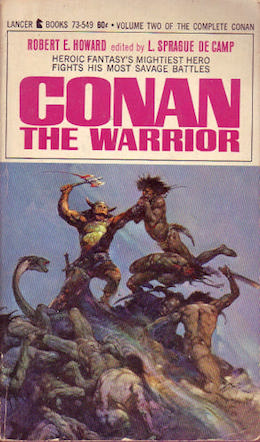In this monthly series reviewing classic science fiction books, Alan Brown will look at the front lines and frontiers of science fiction; books about soldiers and spacers, explorers and adventurers. Stories full of what Shakespeare used to refer to as “alarums and excursions”: battles, chases, clashes, and the stuff of excitement.
I’m flexing the format of this series a bit this month to cover a book that isn’t science fiction, but is certainly full of alarums, excursions, and the stuff of excitement. In the late 1960s, a series of paperback books—with dynamic and evocative covers painted by Frank Frazetta at the peak of his talents—gave an old pulp character, Conan the Barbarian, new recognition. The wild success of paperback editions of J.R.R. Tolkien’s Lord of the Rings trilogy had revealed a desire for fantasy stories that publishers were eager to satisfy. And while Robert E. Howard had first written the adventures of Conan back in the 1930s, and the character had a strong cult following for decades, new editions of his adventures appeared on book racks in stores across America and gained wide popularity. Howard’s brand of fantasy stood out from the crowd. There were no elves and fairies in his work. Instead, he offered a lusty and vigorous hero who met all challenges, whether physical or magical, with his mighty strength, fighting skill, and cold steel.
“What are you reading?” I was startled, and looked up. As I remember, it was 1969, and our high school JV soccer team was riding a bus to the State finals. I was one of those team members that would spend most of the game on the bench, “riding pine,” as it was called. I flinched. The question was coming from one of the stars of the team. He was a nice enough guy, but I had learned that attention from the more popular kids could often lead to mockery. I held up the paperback and showed him. “Conan the Warrior. I’ve heard of him,” he replied. “Do you mind if I take a look?” I handed him the book, he went to his seat. Soon he was totally absorbed, and I spent the rest of the ride staring out the window. I was surprised. No one, except a few fellow science fiction fans, liked the same books I did. For once, could I have stumbled on something that was popular?
The Lancer Paperbacks
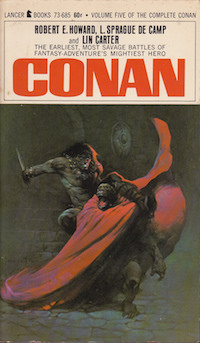 At the time, paperback publisher Lancer Books was publishing a series of books that collected the adventures of Robert E. Howard’s character Conan, who had appeared in the pulp magazine Weird Tales during the 1930s as well as in books from the small publishing house Gnome Press during the 1950s. After the rights to the Conan stories had passed from hand to hand for many years, they were obtained by noted SF author L. Sprague de Camp, an avid fan of Howard’s work. De Camp arranged the stories in chronological order, showing Conan growing from a young reaver to an aged king. He and other collaborators polished the stories, finished fragments and unpublished work, recast Howard stories featuring other characters as Conan stories, and wrote pastiches that filled holes in Conan’s career. They presented the stories with essays on the history of Howard’s Hyborian Age, and added bridging materials that explained how Conan got from one story to the next. Those Lancer paperbacks were distinctive on book racks not only for the bold Frazetta covers, but because the page edges were dyed with a bright purple. (This was appropriate, because if I could choose one word to describe Howard’s prose, it would be “purple.”)
At the time, paperback publisher Lancer Books was publishing a series of books that collected the adventures of Robert E. Howard’s character Conan, who had appeared in the pulp magazine Weird Tales during the 1930s as well as in books from the small publishing house Gnome Press during the 1950s. After the rights to the Conan stories had passed from hand to hand for many years, they were obtained by noted SF author L. Sprague de Camp, an avid fan of Howard’s work. De Camp arranged the stories in chronological order, showing Conan growing from a young reaver to an aged king. He and other collaborators polished the stories, finished fragments and unpublished work, recast Howard stories featuring other characters as Conan stories, and wrote pastiches that filled holes in Conan’s career. They presented the stories with essays on the history of Howard’s Hyborian Age, and added bridging materials that explained how Conan got from one story to the next. Those Lancer paperbacks were distinctive on book racks not only for the bold Frazetta covers, but because the page edges were dyed with a bright purple. (This was appropriate, because if I could choose one word to describe Howard’s prose, it would be “purple.”)
The tales were not simply brimming with emotion; they seemed to throb and pulsate with barely contained emotion. I will caution modern readers that the stories are marred by the cultural, racial, and gender prejudices of the time, and Howard sometimes used racial stereotypes as a substitute for characterization, especially for minor characters. But Howard also presented admirable characters from a variety of races and cultures, and some remarkably strong female characters. Certainly, the pirate queen Belit and Red Brotherhood mercenary Valeria displayed an impressive degree of agency that many other female characters of the era were lacking.
About the Author
Robert E. (Ervin) Howard (1906-1936) was a writer for pulp magazines who had a short but prolific career before his untimely death by suicide. He is noted for his contributions to Weird Tales, and as an early creator of what became known as the “sword and sorcery” genre, combining fantasy and horror elements with medieval military adventure. Howard was extremely well read, and his knowledge of history gave the mythical Pre-Cataclysmic and Hyborian Ages a realistic foundation that anchored the fantastical elements. He was also influenced by other contributors to the pulps, and corresponded and shared ideas with a number of them, including H. P. Lovecraft. His most notable characters were Conan and Kull, proto-Celtic barbarians who became kings of more civilized countries. Howard reportedly hated authority, which made writing an ideal occupation for him, although the profession’s erratic income may have contributed to his eventual suicide, along with romantic disappointments and grief over his dying mother. His work was known for its energy, passion, and the rapid pace of the plots. His greatest success came after his death, and his work is now widely known and remains a strong influence in popular culture.
Conan the Warrior
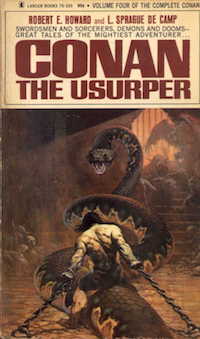 Conan the Warrior was my personal favorite of the Lancer Conan books, the second volume in the series. While I didn’t realize it at the time, unlike some other volumes, the stories in this book were written by Howard himself, at the end of his life, when he was at the height of his powers. Only the introduction and bridging materials came from other authors.
Conan the Warrior was my personal favorite of the Lancer Conan books, the second volume in the series. While I didn’t realize it at the time, unlike some other volumes, the stories in this book were written by Howard himself, at the end of his life, when he was at the height of his powers. Only the introduction and bridging materials came from other authors.
“Red Nails” opens from the viewpoint of the swordswoman Valeria, who flees a mercenary camp in the eastern wastelands to escape amorous advances from a superior officer. Conan, attracted to her, has followed her out of camp. This is fortunate for her, because he soon saves her from an attack by a dragon, described by Howard as a magically re-animated dinosaur rather than a creature of fantasy. Concerned that they will be attacked by other creatures, the two make for a city in the distance, a mysterious structure without any working fields or signs of life surrounding it. They enter the city to find it inhabited by two feuding clans, locked in a struggle that had gone on for decades. Encountering an inhabitant of the city, Conan and Valeria rescue the man, slaying a war party that threatens him and evading some sort of monster lurking in the darkness. The man they saved leads them to his home, where they find a faction led by a man named Olmec and the witch Tascela, both of whom are immediately attracted to Valeria. Olmec’s attraction is sexual, while Tascela’s has a more sinister quality and purpose.
In addition to the two warring factions, the ancient wizard Tolkemec lurks in the tunnels beneath the city. Valeria foils a kidnapping attempt, and soon she and Conan find themselves in a struggle to the death between the two factions, the witch, and the ancient wizard. Conan stories are often brutal, but this one is replete with violence and cruelty. After the kidnapping attempt, Valeria not only beats a maid to get information, but the narrative makes a point of describing how she strips the maid naked and ties her down before the beating. There is treachery and betrayal at every turn. There are monstrous creatures in the story, but the real monsters are the inhabitants of the city, warped by hatred. The story offers a bleak view of a civilization decaying into decadence and death.
“Jewels of Gwahlur” is a more straightforward narrative. Conan is working as a mercenary in Keshan, a nation located in lands roughly analogous to modern Africa. Another mercenary, Thutmekri, has gotten the ear of Conan’s employer, the high priest Gorulga, and convinced him to seek guidance from an ancient oracle, the dead priestess Yelaya, located in a lost city where the legendary jewels of the title are hidden. To salvage something from the situation, Conan decides to beat them to the city and steal the jewels. He arrives to find the mummified body of the ancient priestess replaced by a young dancing girl, who has been coached by his rival to tell Gorgula to slay Conan and give Thutmekri the jewels. Conan convinces the girl to turn this situation around to his advantage, but everyone’s plans are foiled by the mysterious guardians of the jewels, fierce apelike creatures who wreak havok among the interlopers. This story does not rank among Howard’s best, with a predictable plot; its main attraction is the evocative description of the lost city, the crater-like valley that contains it, and the mysterious and vicious creatures that inhabit it, which gives the story a strong sense of place and setting.
“Beyond the Black River” is set on the western border of the Bossonian marches, which separate the kingdom of Aquilonia from the lands of the savage Picts. The story is told from the viewpoint of a Tauran woodsman, Balthus, seeking opportunity on the frontier, who is saved by Conan from a Pictish ambush. Conan is operating as a mercenary scout out of Fort Tuscelan, and warns Balthus that a Pictish wizard and master of magical beasts, Zogar Sag, is uniting the tribes to drive out the settlers who are pushing into disputed border lands. The fort’s commandant tasks Conan to lead an expedition to assassinate Zogar Sag and thwart the enemy attack. Balthus joins the expedition, and they head off into the Pictish wilderness beyond the river, where things do not go as planned.
This story is one of Howard’s best, fast-paced and gripping. It is blunt and brutal, the literary equivalent of a punch in the nose. It is also a uniquely American story, with its settlers contesting natives for control of a forested frontier. Drop the magical beasts, substitute Native Americans for Picts, rifles for bows, tomahawks for swords, and Natty Bumpo and Chingachgook for Balthus and Conan, and it could be a tale written by James Fenimore Cooper. You can see Howard taking Conan in a different direction here than in earlier tales. The story ends with a statement that is often quoted, as it seems to sum up Howard’s bleak views on mankind. “Barbarism is the natural state of mankind… Civilization is unnatural. It is a whim of circumstance. And barbarism must always ultimately triumph.”
Conan in Other Books and Media
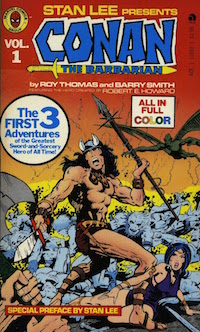 The Lancer paperbacks sparked a new level of interest in Conan that has continued to this day. Over the years, many publishers and authors have created new adventures for Conan. The most prolific of these was Tor Books, publishing over 40 Conan books beginning in the early 80s, many written by Robert Jordan. But while the new adventures were popular, there are also many fans of Howard’s work in its original form who view what de Camp and other authors had done as meddling. The original works were unavailable for decades until the 2000s, when Howard’s original manuscripts were finally collected by Del Rey Books in a three-volume set that includes The Coming of Conan the Cimmerian, The Conquering Sword of Conan, and The Bloody Crown of Conan. Because the pages of my original Lancer paperback version of Conan the Warrior are so fragile, while I read the introduction and bridging materials from that book to prepare this essay, I read the actual stories from those newer Del Rey editions.
The Lancer paperbacks sparked a new level of interest in Conan that has continued to this day. Over the years, many publishers and authors have created new adventures for Conan. The most prolific of these was Tor Books, publishing over 40 Conan books beginning in the early 80s, many written by Robert Jordan. But while the new adventures were popular, there are also many fans of Howard’s work in its original form who view what de Camp and other authors had done as meddling. The original works were unavailable for decades until the 2000s, when Howard’s original manuscripts were finally collected by Del Rey Books in a three-volume set that includes The Coming of Conan the Cimmerian, The Conquering Sword of Conan, and The Bloody Crown of Conan. Because the pages of my original Lancer paperback version of Conan the Warrior are so fragile, while I read the introduction and bridging materials from that book to prepare this essay, I read the actual stories from those newer Del Rey editions.
Rights to publish Conan’s adventures were obtained by Marvel Comics in the 1970s. These comics were given a lot of attention by the publisher, and were very successful. The adaptations were primarily written by senior editor Roy Thomas, and the first issues were drawn by Barry Windsor Smith in a distinctive and intricate style unlike that of most comic books of the day. Later, legendary artist and Marvel mainstay John Buscema took over the art, and spent many years with the character. Eventually, after Marvel lost interest in the character, new versions of the Conan tales appeared in Dark Horse Comics versions.
There were two movies in the 1980s that featured Conan, and starred Arnold Schwarzenegger, Conan the Barbarian and Conan the Destroyer, but the second movie was less popular than the first, and the series ended there. In 2011, there was another attempt to revive the Conan movie franchise, Conan the Barbarian, starring Jason Momoa, but the movie did not do well critically or financially. Over the years, there have been three TV series featuring Conan (two animated series, and one live-action show), and Conan has also appeared in many video games, board games, and roleplaying games.
Final Thoughts
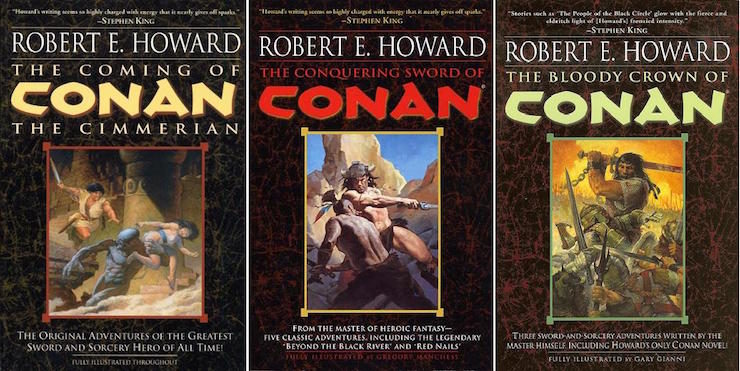
At the end of that high school bus ride, I got Conan the Warrior back. “This is awesome,” said the borrower. “And there are more of these?” I nodded and he said, “I’m going to have to look for them.” And just like that, a barrier had been broken. Conan appealed not just to SF and fantasy fans, but to anyone who liked a gripping adventure story. The 1960s initiated a flood of entertainment that spilled outside the bounds of SF fandom—not just Conan, but the The Lord of the Rings, the original Star Trek and other SF TV shows. And with the 70s came even more wildly popular, mainstreamed SFF, the most notable example being Star Wars. In contrast with my youth, formerly insular geek culture has now become popular culture, with so much of our entertainment infused with concepts from science fiction and fantasy. I will always remember, because of my personal experience, the way Conan opened doors. Thanks to the evocative tales of Robert E. Howard, Conan smashed down the gates of geekdom in the real world, just like he destroyed so many barriers during the Hyborean Age.
Now, I’m interested in your thoughts. What do you think about the Conan tales? Have they aged well? Which of them are your favorites? And do you see the success of the Conan tales as one of the factors that helped bring science fiction and fantasy to a larger audience?
Alan Brown has been a science fiction fan for five decades, especially science fiction that deals with military matters, exploration and adventure. He is also a retired reserve officer with a background in military history and strategy










